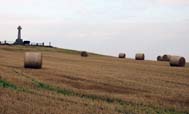The photographs in yesterday’s blog post were taken at Flodden Field, which over the years has witnessed many battles between the English and the Scots. One of the most famous battles was the Battle of Braxton Moor which is more commonly known as the Battle of Flodden Field. It is hard to believe that such a lovely idyllic hillside could have been the site of so much bloodshed.
The website Flodden 1513 has a wealth of information about the battle.
The year 1513 saw Henry VIII campaigning in France, leaving seasoned warrior, the Earl of Surrey, to guard Northern England.
Invoking the Auld Alliance with France, James IV of Scotland crossed the Tweed with a large well-equipped army. He took Norham, Etal and Ford Castles and established a stronghold a mile to the south of here, on Flodden Hill.
Surrey marched his forces north but avoided the Scottish position with a wide flanking move to the east, making his approach to the Battle from the north, via Twizel Bridge.
James was forced to relinquish his fortifications and move his troops and heavy cannon to the ridge of Branxton Hill. The English lines spread out west to east along the ridge on which Branxton stands.
Battle commenced in the late afternoon of 9th September 1513, when the Scots’ guns opened fire. It was dull, damp and muddy, having rained for most of the day.
In the following hours, these fields became the scene of bloody carnage in which an estimated 4,000 Englishmen and 10,000 Scots, including their king and many nobles lost their lives.
Sir Walter Scott describes the battle of Flodden in his poem Marmion.
From Flodden ridge,
The Scots beheld the English host
Leave Barmoor Wood, their evening post
And headful watched them as they crossed
The Till by Twizell Bridge.
High sight it is, and haughty, while
They dive into the deep defile;
Beneath the cavern’d cliff they fall,
Beneath the castle’s airy wall.
By rock, by oak, by Hawthorn tree,
Troop after troop are disappearing;
Troop after troop their banners rearing
Upon the eastern bank you see.
Still pouring down the rocky glen,
Where flows the sullen Till,
And rising from the dim-wood glen,
Standards on standards, men on men,
In slow procession still,
And sweeping o’er the Gothic arch,
And pressing on in ceaseless march,
To gain the opposing hill.
More of the poem can be heard on the following YouTube video:








I went through all the castles you mentioned trying to eliminate them and be left with the right answer. I dismissed Alnwick and Sir Walter Scott, the two links which should have given me the answer. I came up with Edge Hill but there was no castle connection. Well done, I was stumped.
Thanks After you got so close I wondered if you would be able to work it out
After you got so close I wondered if you would be able to work it out 
Hindsight is a wonderful thing. It was a photo of a field, I suspected a battle field, I should have gone for those ending in field and worked backwards!
I was impressed with how close you got to the right answer.
I’d never have got that.
I thought you might have and idea because of your question about Norham castle.
Fascinating, Cherie. Know next to nothing about the period, so delighted with the info. I have visited Flodden; but it was years ago.
I am glad you enjoyed the info When I looked, those pictures where taken 6 years ago. It was before the times of my digital camera, so they are scanned copies
When I looked, those pictures where taken 6 years ago. It was before the times of my digital camera, so they are scanned copies 
Ah I wouldn’t have thought of Flodden
Cherrypie: Off topic. You get a mention in dispatches…
Guardian Comment is free
Good article I am sure there are going to be some very interesting remarks that end up in that comment thread!
I am sure there are going to be some very interesting remarks that end up in that comment thread!
[...] Flodden Field – Brief description plus an excerpt from Marmion by Sir Walter Scott [...]
[...] This is the first of what is intended to be a series of posts highlighting the places that were significant to the Battle of Flodden. [...]